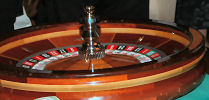Chapter 9
Probability and Integration
9.1 Reliability Theory: How Long Do Things Last?
Exercises
- We have a collection of four types of bulbs, each with an exact lifetime and a probability of occurrence as given in Table E1. What is the expected lifetime of a bulb chosen at random from this collection?
Table E1 Lifetimes for idealized light bulbs Type `k` Probability `p_k` Exact lifetime `t_k` (days) 1`1/4``22`2`1/3``46`3`1/4``64`4`1/6``82` - We have a collection of five types of bulbs, each with an exact lifetime and a probability of occurrence as given in Table E2. What is the expected lifetime of a bulb chosen at random from this collection?
Table E2 Lifetimes for idealized light bulbs Type `k` Probability `p_k` Exact lifetime `t_k` (days) 1`1/10``15`2`1/10``22`3`1/5``41`4`1/5`52`5`2/5``60`  Each of the numbers `1`, `2`, `3`, `4`, `5`, and `6` appears on one face of a fair six-sided die. What is the average value that will appear on the top face in a random roll?
Each of the numbers `1`, `2`, `3`, `4`, `5`, and `6` appears on one face of a fair six-sided die. What is the average value that will appear on the top face in a random roll?
- Each of the numbers `1`, `3`, `6`, `10`, `15`, and `21` appears on one face of a fair six-sided die. What is the average value that will appear on the top face in a random roll?
- Suppose the die in Exercise 4 is "loaded" so that `1` and `3` each appear with probability `1/8`, `6` appears with probability `1/4`, and the remaining three values each appear with probability `1/6`. If the die is rolled many times, what is the average value that will appear?
 An American roulette wheel has 38 "pockets" into which the ball may drop, all equally likely on any one spin of the wheel. Two of these are green and always result in wins for the "house", i.e. losses for the gambler. The others are numbered from 1 to 36, half colored red and half black.
A successful bet on "red" or "black" or "even" or "odd" — each represented by 18 of the 38 pockets — pays 1 to 1, that is, the gambler gets back the original bet plus an equal amount. If the bet is unsuccessful, the house keeps the amount bet. How much does it cost, on average, to bet `\$`1 on one of these four strategies?
An American roulette wheel has 38 "pockets" into which the ball may drop, all equally likely on any one spin of the wheel. Two of these are green and always result in wins for the "house", i.e. losses for the gambler. The others are numbered from 1 to 36, half colored red and half black.
A successful bet on "red" or "black" or "even" or "odd" — each represented by 18 of the 38 pockets — pays 1 to 1, that is, the gambler gets back the original bet plus an equal amount. If the bet is unsuccessful, the house keeps the amount bet. How much does it cost, on average, to bet `\$`1 on one of these four strategies?
- A certain gambling game has a payoff of `\$`10 with probability `1/100`, a payoff of 10¢ with probability `1/3`, and otherwise no payoff. What is the expected per-play winning if this game is played many times? Is it reasonable to pay 25¢ to play?
- A random bulb from a batch of light bulbs has a probability `F(t)=1-e^(-0.063 t)` of burning out before `t` days.
- What is the probability that a random bulb will burn out after day 3 and before day 10?
- Find the expected lifetime of a random bulb.
- A random bulb from a batch of light bulbs has a probability `F(t)=1-e^(-0.081 t)` of burning out before `t` days.
- What is the probability that a random bulb will burn out after day 2 and before day 15?
- Find the expected lifetime of a random bulb.
- A random bulb from a batch of light bulbs has a probability `F(t)=1-e^(-0.013 t)` of burning out before `t` days.
- What is the probability that a random bulb will burn out after day 20 and before day 35?
- Find the expected lifetime of a random bulb.
- Evaluate each of the following indefinite integrals.
a. `int_ ^ t e^(-3t) dt` b. `int_ ^ t^2 e^(-rt) dt` c. `int_ ^ 1/(1+4t^2) dt` - Evaluate each of the following definite integrals.
a. `int_0^5 t e^(-3t) dt` b. `int_0^10 t e^(-3t) dt` c. `int_0^20 t e^(-3t) dt` d. `int_0^5 t^2 e^(-rt) dt` e. `int_0^10 t^2 e^(-rt) dt` f. `int_0^20 t^2 e^(-rt) dt` g. `int_0^100 1/(1+4t^2) dt` h. `int_0^200 1/(1+4t^2) dt` i. `int_0^300 1/(1+4t^2) dt` - When `F(b)-F(a)` turned up in our discussion of probability, you might have guessed there must be an integral lurking nearby — but the integral `int_0^T ``t e^(-rt) dt` is not `F(b)-F(a)`, and it is also not a probability. Use the function `f` to express as an integral the probability that a particular bulb will fail between time `t=a` and time `t=b`.
-
- Now that you have completed the development of the concept of expected lifetime, starting with a discrete approximation to the continuous problem, where have you seen this problem before? Where did integrals like `int_0^T ``t f(t) dt` turn up in our previous work?
- Use the analogy with a physical problem to interpret expected lifetime as a "continuous weighted average of times." What function provides the weights, and how are the weights related to probabilities?

